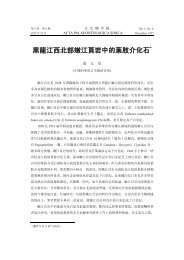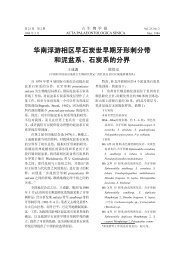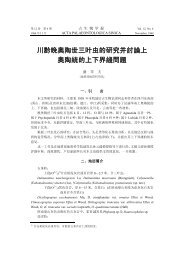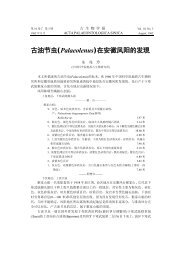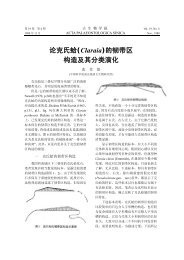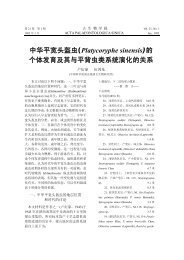ephedroids from the Early Cretaceous Yixian Formation in Liaoning ...
ephedroids from the Early Cretaceous Yixian Formation in Liaoning ...
ephedroids from the Early Cretaceous Yixian Formation in Liaoning ...
Create successful ePaper yourself
Turn your PDF publications into a flip-book with our unique Google optimized e-Paper software.
242 C. Ryd<strong>in</strong> et al.: <strong>Cretaceous</strong> <strong>ephedroids</strong> <strong>from</strong> Ch<strong>in</strong>a<br />
1999 Liaoxia chenii Cao et S.Q. Wu — Wu p.<br />
21, plate XIV:3, XV:3.<br />
2000 Ephedrites chenii (Cao et S.Q. Wu) Guo<br />
et X.W. Wu — Guo and Wu p. 86, plates I:1–<br />
4, II:1–4.<br />
2001 Ephedrites chenii (Cao et S.Q. Wu) Guo<br />
et X.W. Wu — Sun et al. p. 206, plates 24:2,<br />
64:1, 3–6 (non plate 64:7–9).<br />
2003 Liaoxia chenii Cao et S.Q. Wu — Chang,<br />
p. 174, Fig. 241.<br />
Emended specific diagnosis. As for <strong>the</strong><br />
genus with <strong>the</strong> follow<strong>in</strong>g dist<strong>in</strong>ctions. Branches<br />
c. 0.5–3.0 mm wide, <strong>in</strong>ternodes 8–40 mm long.<br />
Leaves 5–20 mm long, with two parallel ve<strong>in</strong>s.<br />
Cones obovate, 4–10 mm long, 2–5 mm wide,<br />
with 2–6 pairs of bracts. Cone bracts ovate to<br />
triangular and reflexed, c. 4 mm long, with an<br />
acute to attenuate apex, two parallel ve<strong>in</strong>s.<br />
Seeds ovoid to elliptic, c. 1 mm long, c. 0.3–<br />
0.7 mm wide.<br />
Holotype. PB17800 (Fig. 1).<br />
Paratype. PB17801.<br />
Type locality. Near Chaomidian at Shangyuan<br />
Village of Beipiao, Liaon<strong>in</strong>g, Ch<strong>in</strong>a.<br />
Stratigraphic position and age. Jianshangou<br />
Bed, <strong>Yixian</strong> <strong>Formation</strong>, <strong>Early</strong> <strong>Cretaceous</strong><br />
(Barremian-early Aptian?).<br />
Comments on <strong>the</strong> type material. The holotype<br />
of Liaoxia chenii (PB17800, Cao et al.<br />
1998) (Fig. 1) is a reproductive shoot, c. 9 cm<br />
long. It is clearly ephedroid <strong>in</strong> gross-morphology<br />
with striate stems, 1–3 mm wide. Branch<strong>in</strong>g<br />
is opposite and decussate with dist<strong>in</strong>ct<br />
nodes. Internodes are 8–40 mm long. Leaves<br />
are l<strong>in</strong>ear, at least 20 mm long and c. 1–2 mm<br />
wide, probably with two parallel ve<strong>in</strong>s. Cones<br />
are 5–10 mm long and 3–4 mm wide, obovate<br />
with 2–6 pairs of reflexed cone bracts, c. 4 mm<br />
long, and ovate with an attenuate apex. Cone<br />
bracts have two parallel ve<strong>in</strong>s.<br />
Note that <strong>in</strong> <strong>the</strong> description of Ephedrites<br />
chenii <strong>in</strong> Sun et al. (2001), two additional<br />
specimens (plate 64, Figs. 7–9) are presented.<br />
These fossils may be ephedroid, but <strong>the</strong>y lack<br />
features characteris<strong>in</strong>g Liaoxia and are not<br />
<strong>in</strong>cluded here <strong>in</strong> <strong>the</strong> synonymy list of Liaoxia<br />
chenii.<br />
New material of Liaoxia chenii. Specimens<br />
PB20717–PB20718 (Figs. 2–4) <strong>from</strong> <strong>the</strong> Huangbanjigou<br />
Section, <strong>in</strong>cludes two compression<br />
fossils with oxidized organic material. The<br />
specimens show dist<strong>in</strong>ct features of Liaoxia<br />
chenii and are here <strong>in</strong>cluded <strong>in</strong> this species. In<br />
one specimen <strong>the</strong> uppermost 5 cm of a<br />
branched plant, c. 13 cm wide, is preserved<br />
(Figs. 3–4). The o<strong>the</strong>r specimen is a detached<br />
apical part of a reproductive shoot, 2.5 cm<br />
long (Fig. 2). Stems are erect with 8–17 mm<br />
long <strong>in</strong>ternodes, longitud<strong>in</strong>ally striate and<br />
2 mm wide <strong>in</strong> basal parts and 0.5 mm <strong>in</strong> upper<br />
parts, thicker at nodes. Phyllotaxis is opposite<br />
and decussate. Leaves are l<strong>in</strong>ear (Figs. 2–3), up<br />
to at least 7 mm long and 0.1–0.3 mm wide.<br />
Venation is <strong>in</strong>dist<strong>in</strong>ct, but <strong>the</strong>re are apparently<br />
two parallel ve<strong>in</strong>s <strong>in</strong> each leaf. Cones are<br />
axillary at nodes or term<strong>in</strong>at<strong>in</strong>g branches,<br />
sessile or pedunculate, and obovate to elongate,<br />
4–7 mm long, 2.5–5 mm wide and with<br />
2–6 pairs of bracts. Cone bracts are delicate<br />
and with two ve<strong>in</strong>s (Fig. 3). They are narrowly<br />
ovate with an acute to attenuate apex, 3–4 mm<br />
long, about 0.8 mm wide at <strong>the</strong> base, 0.3<br />
towards <strong>the</strong> apex, decussately arranged and<br />
often reflexed to a position almost at a right<br />
angle to <strong>the</strong> cone axis. A few seeds are<br />
preserved <strong>in</strong> <strong>the</strong> axils of apical or distal cones<br />
bracts of some cones (<strong>in</strong>dicated by an arrow <strong>in</strong><br />
Fig. 3). They are ovoid and 0.9–1.1 mm long<br />
and 0.3–0.7 mm wide. No <strong>in</strong>ternal or external<br />
anatomical details are preserved.<br />
Liaoxia changii (Cao et S.Q. Wu) Ryd<strong>in</strong>,<br />
S.Q. Wu et Friis comb. nov.<br />
Basionym. Eragrosites changii Cao et S.Q.<br />
Wu (Cao et al., February 1998. Ch<strong>in</strong>ese Sci.<br />
Bull. 43: p. 231, plate II:1–3).<br />
Synonyms and previously published material.<br />
1999 Liaoxia changii Cao et S.Q. Wu — Wu, p.<br />
21, plate XV:1, 4.<br />
2000 Ephedrites chenii (Cao et S.Q. Wu) Guo<br />
et X.W. Wu — Guo et Wu p. 86, plates 1:5–7<br />
and 2:5–8.




